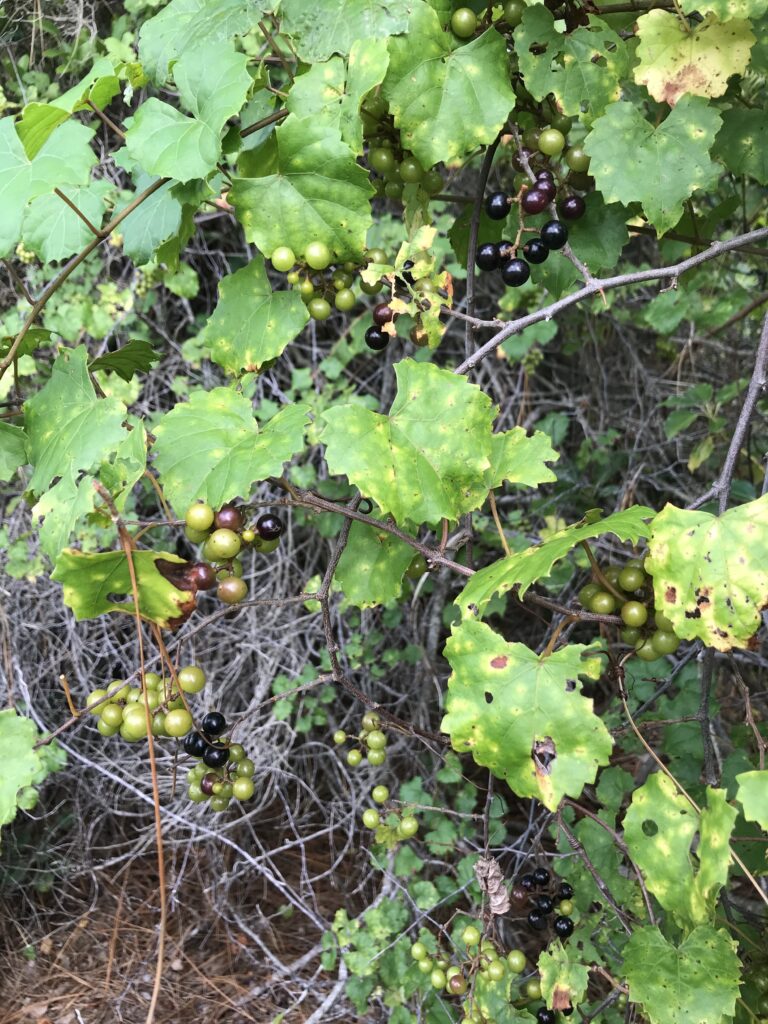
Vitis munsonianna, photto by Green Deane
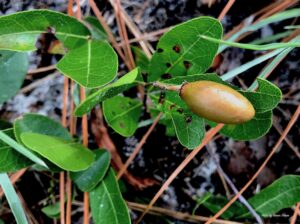
Unripe gopher apple, photo by Green Deane
We are grapes last weekend in Melbourne, both single-tendril and forked tendril, south of the horseshoe pit at Wickham Park. (we went around the construction.) The grapes were a couple of weeks early, which is close enough for Mother Nature’s standards. Also abundant but not yet ripe were Gopher Apples, still too hard to eat for humans. When ripe gopher apples turn pink and pasty, and a sweet, similar in taste (for most) as pink baseball bubble gum. They don’t travel well.
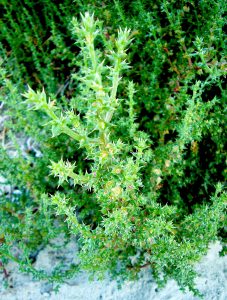
I find Russian Thistles in front of hotels on Daytona Beach. Photo by Green Deane
We shouldn’t forage along railroad tracks and you can blame it all on the Russian Thistle. This species, best known as the tumble weed that rolls across the wild west in movies, came with immigrants to southern South Dakota in the early 1870’s. Best guess is it contaminated their flax seed. By 1895 it reached New Jersey and California. The question was how? A professor who worked for the Department of Agriculture figured out the trains were spreading the seeds coast to coast. It was a remarkable idea at the time and brought him much fame. His solution to the unintentional distribution? Kill plants long railroad tracks. Thus began the practice of putting down some mighty and long-lasting chemicals to kill weeds sprouting amongst the iron rails. Railroad tracks are a good place to find seeds to take home and plant but not to find food. There have even been a few reported deaths from foraging along rail road tracks.
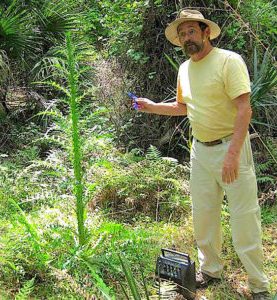
Foraging classes are held rain or shine, heat or cold. Photo by Nermina Krenata
Foraging classes: I was originally going to go to north FLorida this weekend, but weather forecasts suggest it could be drenched by an off-shore system, so I am heading southwest.
July 29th, Red Bug Slough , Sarasota. 9 a.m. Because of rennovations, we have to meet at a different location at Red Bug Slough in Sarasoata. Normally it is at 5200 S. Beneva Road. Instead we will have to park at Gypsy Street and South Lockwood Ridge Road. Gypsy can be reached by Camphor Ave which runs south of Proctor west of Beneva.
July 30th, Bayshore Live Oak Park, Bayshore Drive. Port Charlotte. 9 a.m. Meet at Bayshore and Ganyard.
August 5th, Boulware Springs Park, 3420 SE 15th St., Gainesville, FL 32641. 9 a.m. Meet at the pavilion by the pump house.
August 12th, Mead Garden: 1500 S. Denning Dr., Winter Park, FL 32789. Meet at the bathrooms 9 a.m.
For more information, to pre-pay or to sign up go here.
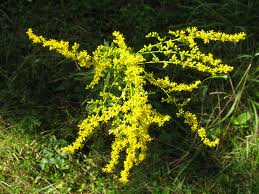
Goldenrod is ruderal, pHoto by Green Deane
Also seen blooming now is Goldenrod. It is a bit of a treasure hunt and disappointment. The treasure hunt is that one species is better than all the rest for tea, Solidago odora. It does grow here, has an anise flavor, but is hard to find. It’s reported in most counties but is not common. Goldenrod grows in about half of the United States, southwest to northeast. Other Goldenrod species can also be made into tea, perhaps all of them particularly for herbal applications, but they don’t taste anywhere near as good. In fact, after the “Boston Tea Party” of 1773 halted tea imports colonialists drank Goldenrod tea and even exported some to China. It did not catch on. However, every time I see a Goldenrod I pull off a leaf and crush it hoping to detect the tell-tale anise smell. It’s a golden treasure hunt.
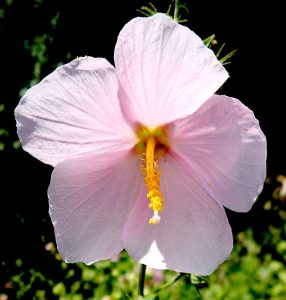
The mysterious Swamp Mallow. Photo by Green Deane
Notice while crossing the St. Johns River Hibiscus moscheutos one of my mystery plants that ranges over much of the United States except for the high plains states and the west coast (and my native state of Maine.) The Swamp Rose Mallow is blossoming in damp spots locally particularly along the St. John River. I think its blossoming is more related to the shortening of the days than the weather per se. It has five separate petals united at the base and five green sepals. The blossom lasts only one day. They range from cream with a red or purple center to pale pink. It has a sticky, stringy juice. The question is, as a Hibiscus, are the blossoms edible or other parts? I have never found a reference to edibility. In fact, it seems only one Native American tribe used it medicinally, the Shinnecock who lived on what we now call Long Island. They used it for bladder infections. European settlers, however used the species for a wide variety of ailments. As several writers attest it “abounds with mucilage.” It is always interesting when such a wide-spread plant is rarely mentioned in the ethnobotanical literature. That could mean it wasn’t used, we didn’t ask, or they didn’t tell us. To read more about mallows go here.

You get the USB, not the key.
150-video USB would be a good end of spring present and is now $99. My nine-DVD set of 135 videos has been phased out. The USB videos are the same videos I have on You Tube. Some people like to have their own copy. The USB videos have to be copied to your computer to play. If you want to order the USB go to the DVD/USB order button on the top right of this page. That will take you to an order form. I’d like to thank all of you who ordered the DVD set over the years which required me to burn over 5,000 DVDs individually.

Green Deane Forum
Want to identify a plant? Perhaps you’re looking for a foraging reference? You might have a UFO, an Unidentified Flowering Object, you want identified. On the Green Deane Forum we — including Green Deane and others from around the world — chat about foraging all year. And it’s not just about warm-weather plants or just North American flora. Many nations share common weeds so there’s a lot to talk. There’s also more than weeds. The reference section has information for foraging around the world. There are also articles on food preservation, and forgotten skills from making bows to fermenting food.
 Now being printed is EatTheWeeds, the book. It should have 284 plants, 350-plus pages, index and color photos. Several hundred have been preordered on Amazon. Most of the entries include a nutritional profile. Officially it will be published Dec. 5th (to suit the publisher demands) apparently to appeal to the winter market but can be delivered by mid-October
Now being printed is EatTheWeeds, the book. It should have 284 plants, 350-plus pages, index and color photos. Several hundred have been preordered on Amazon. Most of the entries include a nutritional profile. Officially it will be published Dec. 5th (to suit the publisher demands) apparently to appeal to the winter market but can be delivered by mid-October
This is weekly newsletter #567. If you want to subscribe to this free newsletter you can find the sign-up form in the menu at the top of the page.
To donate to the Green Deane Newsletter click here.

